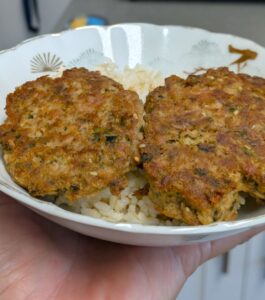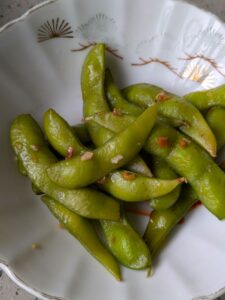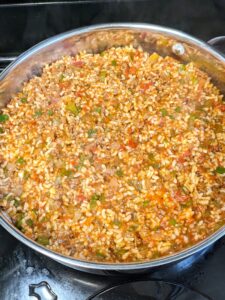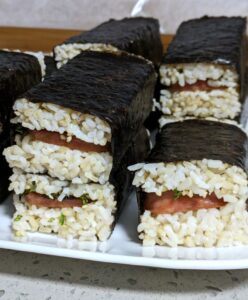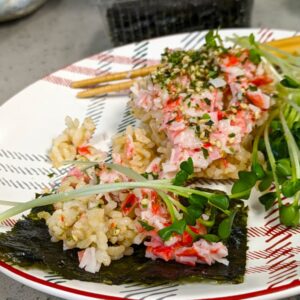As an Amazon Associate I may earn a small amount from qualifying purchases if you follow a link from my site to Amazon.
Growing up my family was so happy to have the convenience of package sushi rice seasoning. It allowed them to make maki sushi (rolled sushi) at home without having to worry about the flavor of the rice. They could focus on preparing the filling and assembling the rolls which is sometimes time consuming. With food costs going up, it’s harder to justify these types of convenience items.
Homemade sushi rice seasoning is easy to do once you figure out the basics. It’s just rice vinegar, salt, and sugar. We use this recipe for 3 cups of cooked medium grain rice. Long grain rice doesn’t stick together much, and glutenous rice is too sticky and more expensive than medium grain rice. While white medium grain is preferred, I have been loving using Genjimai brown rice for sushi rice, too. (Regular brown rice just doesn’t cut it. It’s too hard and doesn’t stick together well.)
My family prefers a lighter sweet vinegar flavor on the sushi rice, or no sushi rice vinegar at all. So this is our go-to recipe. If you like a stronger flavor, then try it with 2 or 2 ½ cups of cooked rice.
Why Make Sushi Rice at Home?

Sushi rice really enhances the flavor of any sushi or sushi-related dish. It has a subtle sweet salty umami flavor that pairs well with most protein, cooked and raw.
There are premade bottled sushi vinegar seasonings and dried packets of sushi seasonings available in Asian markets and Asian sections of your grocery store. These can range in price from $2.00 to $5.00. Save yourself some cabinet space and use the rice wine vinegar, salt, and sugar that you already have at home!
What is rice wine vinegar and do I need it?
Rice wine vinegar is made out of rice fermented in water, creating rice alcohol, which is fermented again to make rice wine vinegar. It has a slightly sour and slightly sweet taste that is delicious and fundamental in many Asian dishes.
You can use other types of vinegar in a pinch. Apple cider and champagne vinegar are probably the best substitute if you can’t find rice wine vinegar or need to spend your pennies elsewhere.
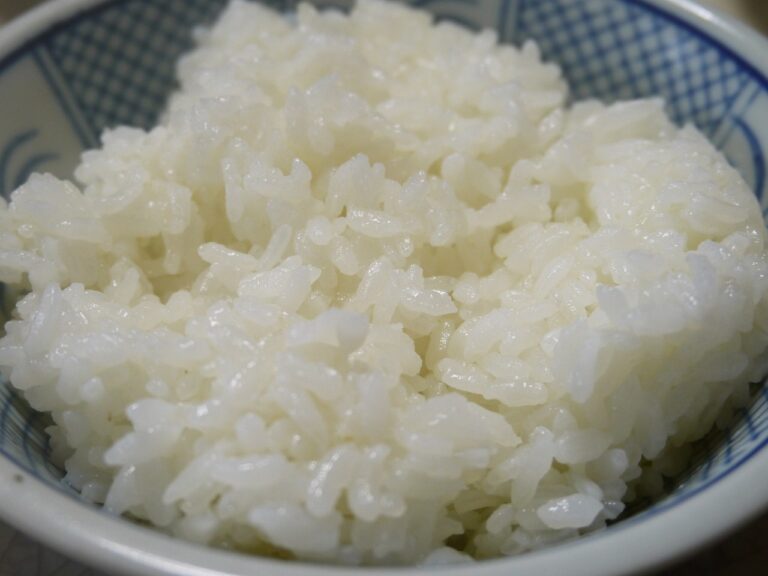
Health Benefits: Rice Vinegar?
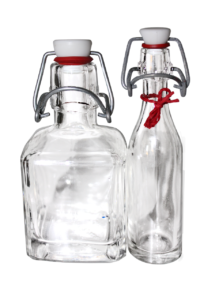
While there are some trace vitamins and minerals in rice vinegar, not enough studies have been done to decide whether there are genuine confirmed health benefits. Maybe the fermentation of the rice to make this vinegar is helpful to gut health. Who knows!
As with many foods, rice vinegar in moderation will help you to eat a variety of foods when used in Asian cuisine. The greater variety of foods you eat will probably take much of the guesswork out of whether you are eating healthy. Try this rice wine vinegar by Kikkoman. It’s tasty, affordable, and I trust their brand because they have the best shoyu (soy sauce).
Try some of these other tasty mostly homemade Asian dishes that your family is sure to love.

Pantry Sushi Rice Seasoning (Small Batch)
Equipment
- 1 small bowl
- 1 Large bowl for the rice
Ingredients
- 1 tbsp coconut sugar or palm sugar
- 1 ½ tbsp rice wine vinegar
- ⅛ tsp salt
Instructions
- Combine the ingredients in a small bowl. Stir until the salt and sugar is fully dissolved. If you can still see the sugar crystals in the bowl, microwave the mixture for 10 seconds at a time until the sugar is melted, mixing in between each 10 second intervals.
- How to Use on Rice: Spread out your piping hot cooked medium grain rice in a large bowl so you have a lot of surface area. Pour the sushi rice vinegar mixture slowly onto the rice. If you have a large spoon or rice paddle, use it by pouring the sushi rice vinegar onto the back of it and move it over the rice while pouring. This will help to evenly distribute the sushi rice vinegar. Mix quickly and thoroughly so all the rice has some sushi rice vinegar.
- Use the seasoned rice in your favorite sushi, sushi bake, or sushi bowl.



